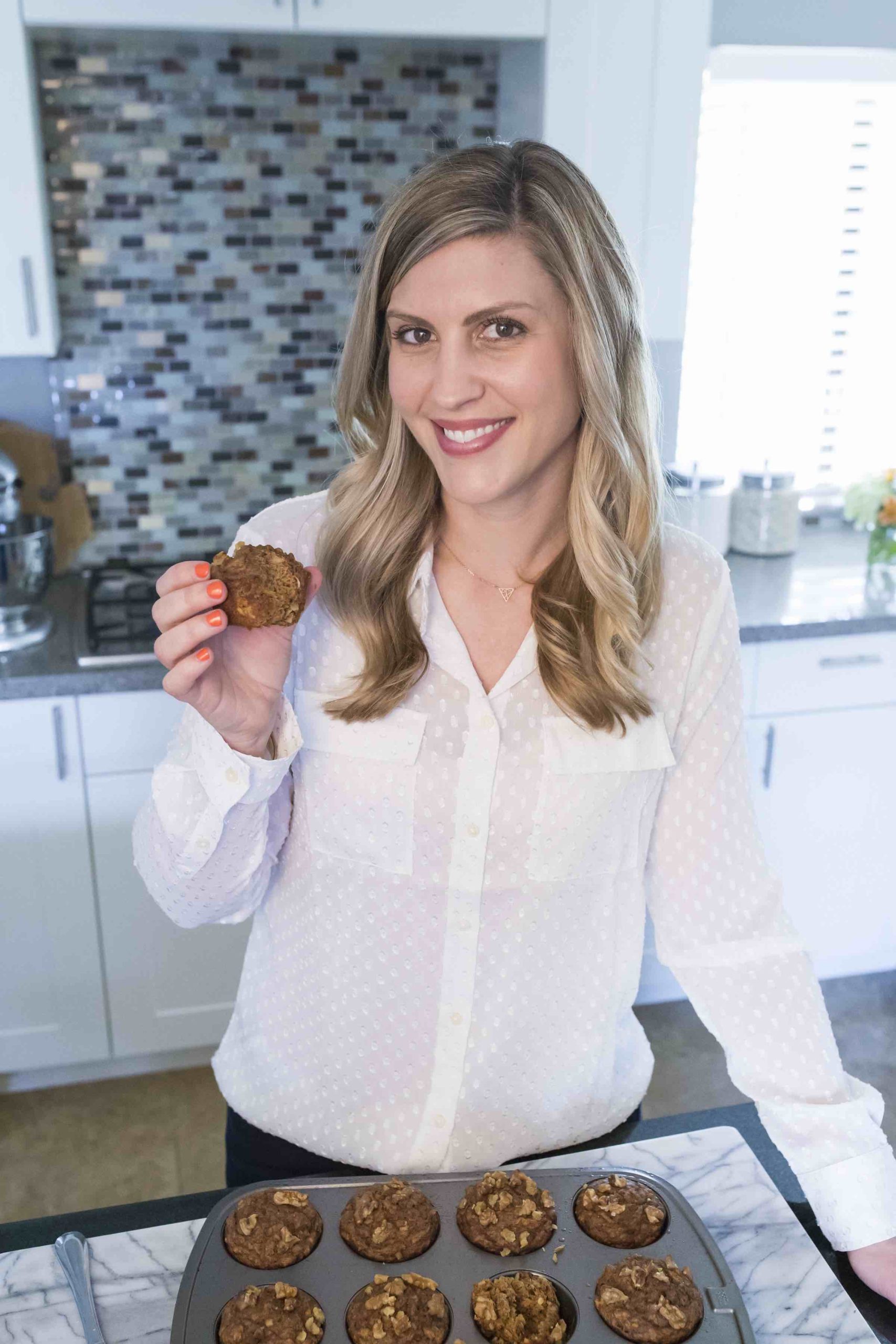If you have (or have had) a toddler, you know all too well how frustrating it is to see them throwing food. I mean, do we need one more thing to clean up as parents? While throwing food is annoying, it’s also a pretty common and developmentally normal toddler behavior.
Toddlers throw food and get up and down from their chairs at the table for many of the same reasons. Additionally, they are learning to express themselves and push boundaries. As parents, it’s our job to create the boundaries they crave and need.
In this article I am going to walk you step by step through the most common reasons your toddler is throwing food and what you can do to stop it.
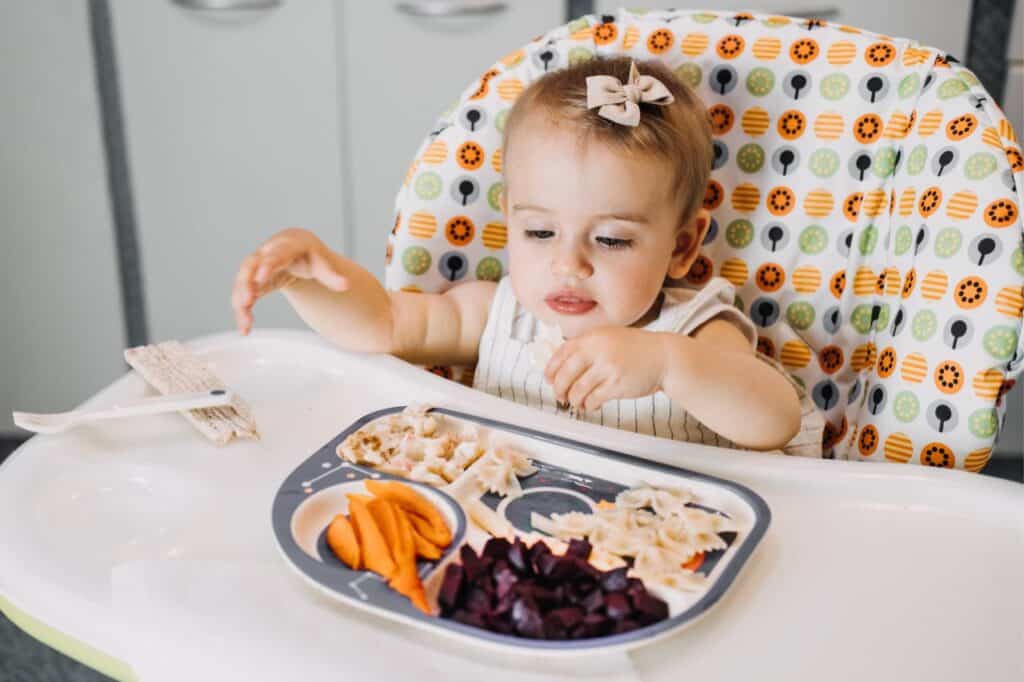
Please note that I am an affiliate for some of the linked products. If you click my affiliate link and make a purchase, I may earn a percentage of the sale at no extra cost to you. As an Amazon Associate, I earn from qualifying purchases.
Table of Contents
Why your toddler is throwing food
I’ve never had my patience tested more than navigating toddlerhood with my kids. Like recently, when my youngest smashed his watermelon all over his head then proceeded to throw the rest on the floor. As frustrating as it was, I knew I had made several key mistakes when serving him his snack.
Throwing food usually happens for one of these primary reasons:
- They’re not hungry
- The mealtime is too long
- They can’t communicate what they want
- They’re seated uncomfortably
- They want your attention
- Seeking sensory input/curiosity
- A dog/pet is entertaining them
- Too much food on their plate
- They don’t like their food
- They’re bored
Let’s walk through what you can do to fix each one of these problems so your toddler will stop throwing food.
1. Create a feeding schedule for your toddler
The problem: your toddler isn’t hungry.
One of the primary reasons I see for food throwing when I am working with my clients is that their toddler isn’t hungry. This is one of the reasons a feeding schedule for toddlers is so important.
Having regular meal and snack times that are appropriately spaced apart will help your toddler come to the table with an appetite. When they are hungry throwing food is less common.
Toddlers ages 1-3 typically need to eat every 2-2.5 hours. Their bellies are about the size of their fist, so they usually don’t eat large quantities at a time. Because of this, they need to eat more frequently than older kids and adults.
Sample feeding schedule for toddlers
- Wake @ 6:45 am
- Breakfast @ 7 am
- Snack @ 9-9:30 am
- Lunch @ 11:30 am
- Nap @ 12-12:30 pm
- Snack @ 2-2:30 pm
- Dinner @ 5 pm
- Bedtime @ 7 pm
As you can see above, this feeding schedule included 3 meals and 2 snacks that were all adequately spaced apart. Sometimes, depending on age and meal timing, your kids might need a bedtime snack as well. Having this spacing allows enough time for their bellies to develop a hunger to eat again.
If your toddler is eating frequent snacks, carrying a snack cup around the house while they play, or allowed open access to food on the table as desired, they likely will never fully develop hunger. Then, when they go to sit down in their high chair or booster chair for a meal, they are ready to play and not eat, so food throwing might begin.
The solution: Outline a meal and snack schedule for your toddler based on what works for your family and their awake/sleep times. This varies by age, number, and length of naps and bedtime. Don’t allow them to eat or drink anything (except water) between the scheduled meal and snack times.
If your toddler isn’t used to a firm schedule, this might be a challenge at first, but stick with it. Remind them when the next meal or snack will be, point to the clock if needed, and re-direct them. With consistency, this will get easier and easier!
2. Shorten your toddler’s mealtime
The problem: mealtime is too long
Many parents have unreasonable expectations for how long their kids should be able to stay seated at the table. This is especially true for toddlers. You can expect your kids to sit at the table for about 2-5 min per year of age.
Recommended meal length by age
- 1 year old: 2-5 min
- 2 year old: 4-10 min
- 3 year old: 6-15 min
If your toddler is sitting at the table beyond those times and happily eating, that is great! But if you notice they are throwing food and it’s been well beyond those times, that might be part of the reason.
I have dreams of the day I will be able to enjoy a slow, relaxing meal with my kids, where we talk about our day, our highs and our lows, and love the food we eat. But, that day isn’t here yet. The reality is that most days my kids are done before I’ve even made a dent in my plate.
This is a season, and it isn’t always easy, but you have to remind yourself that they will grow up and throwing food will be a far-off memory.
The solution: Keep mealtimes short! You can use a timer (based on your kid’s age) and when the timer goes off, let them know they can get up if they are done. If they’re not, great, they can keep eating. But, making your kids sit at the table for 15, 20, or 30 min based on some duration you want mealtimes to be is likely unrealistic.
3. Teach your toddler how to communicate with you
The problem: They don’t know how to tell you what they want.
Toddlers are learning so much so fast, but actual speech takes time to develop. They may not know how to express to you that they are done eating, or that they don’t want/like something. So, they throw it.
The solution: teach them how to tell you what they want and need
Teaching your toddler how to communicate with you (even if they can’t fully talk yet) will help make mealtimes smoother.
One of the things that worked magically with both of my kids (and many of my clients) was to teach them very simple sign language for meals. They quickly mastered “more” and “all done.”
If they can tell you these things at mealtimes it will make it much easier to express when they are ready to get down. This will stop them from throwing food to communicate it.
Two simple signs to teach your toddler to prevent throwing food
There are many more signs regarding mealtimes that you could teach your toddler, but these are the two I find most frequently help with preventing throwing food.
You can also teach them to let you know when they don’t want something by placing it in a separate spot on their tray or by providing them with a separate bowl where they can put unwanted food. When they have a spot to put the food they don’t want, there isn’t as much need to toss it.
4. Get your toddler a chair that will support their body
The problem: their seat is uncomfortable.
Have you ever tried to eat dinner sitting on a barstool with no footrest? I know I have and it is SO uncomfortable! Dangling feet are the worst for eating.
The Solution: Getting your toddler a highchair (or booster chair) that will support their body and their feet makes a HUGE difference in how long they sit at the table. Feeling supported makes them more comfortable and this helps them to stay seated and less wiggly longer.
When they get the wiggles, they are more likely to start throwing food or just get down from the table altogether. Better body support will make a world of difference in your toddlers’ mealtime behavior.
Key things to look for in a supportive toddler chair to prevent throwing food
- The upper and lower body should hold a 90-degree angle (see photo)
- The feet should rest flat on a footrest (no dangling)
- The tabletop should hit them between the belly button and the chest
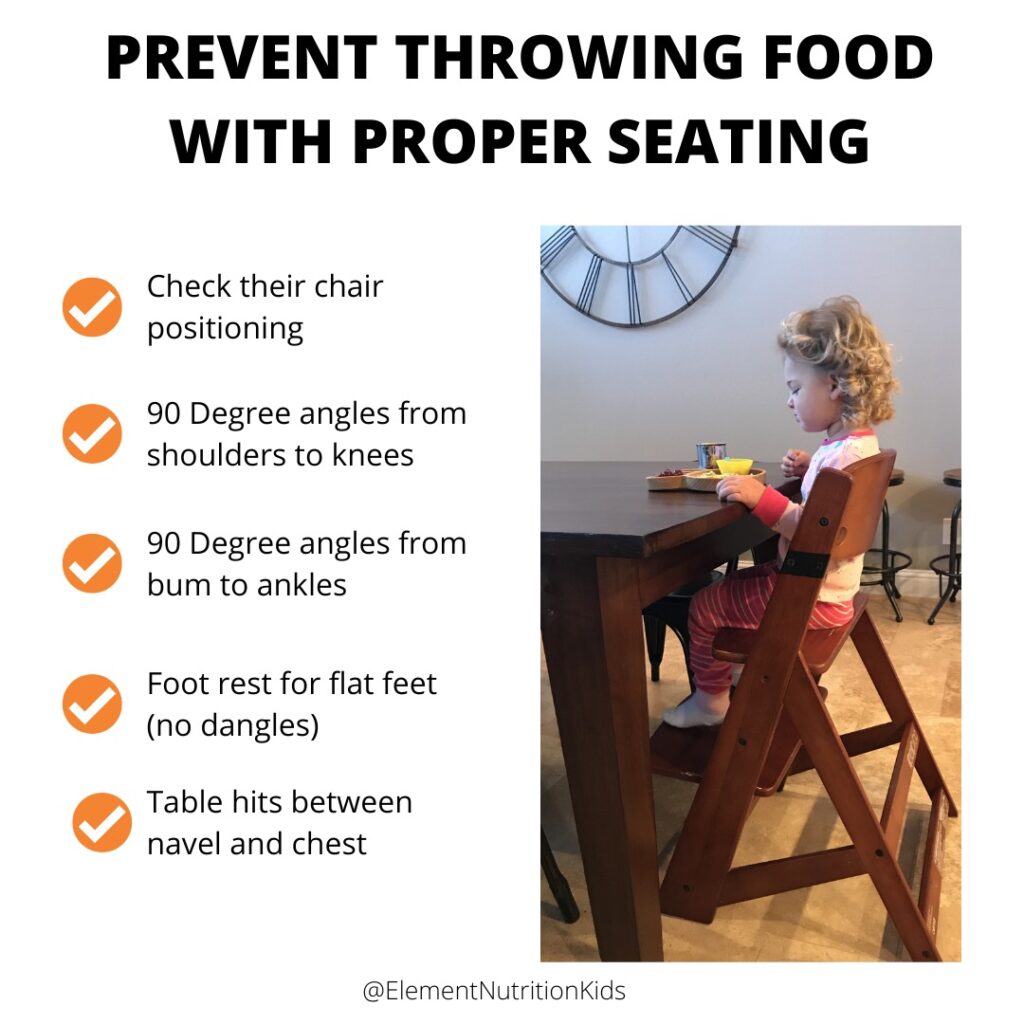
My favorite toddler chair is the Keekaroo right-height chair. I got this highchair for both of my kids when they were a baby and it grows with them. But there are so many similar ones on the market. I will share a few popular ones below.
Favorite toddler high chairs (Amazon links):
- Keekaroo right height (my 2.5-year-old uses this and so does my 6-year-old)
- Stokke Trip Trap
- Abiie Beyond Junior convertible
Bonus tip: Try to buy these used! I found both of my kid’s keekaroo right-height chairs on the Facebook marketplace. They were used but in excellent condition and way less expensive than buying brand new. If you want to snag one of the high chairs from above (or other similar ones), keep your eyes peeled for a good deal.
If you already have a high chair that your toddler sits in, but it doesn’t have a footrest, you might be able to easily modify it by adding a footrest or putting a box or stool under their chair for their feet to rest on.
How to add a footrest to a high chair
If you have one of the popular Ikea high chairs, there are several footrests on the market you can add to the chair.
If your high chair already has a footrest, but it isn’t high enough for your toddler’s feet to rest on it, you can modify it by making it taller.
- Add a pool noodle (or two) to the footrest for height
- Tape a shoebox or other box to the footrest
- Add a durable rubber “thigh band” like the type for exercising around the legs of the chair. You can move it up or down to meet the height you need.
In addition to high chairs, you might also be able to use a booster seat, however, depending on the types of chairs you have at your table a booster seat may not allow for their feet to have something to rest on. If you do use a booster seat, make sure their feet can rest on the chair below, or add a stool or footstool under the chair for support.
5. Sit with your toddler at meals
The problem: They want your attention
I know this one can be really hard. At the time of writing this, my son is 2.5 and there are many times (particularly at lunchtime) when I want to give him his food and then get something done in the kitchen (like tackling all those dishes piled up in the sink.)
However, when your toddler is sitting alone for mealtimes, they are more likely to throw their food. Throwing food gets your attention and I have first-hand experience with this.
Remember my story at the beginning of this post when my toddler smashed watermelon all over his head and then threw it on the floor? He was eating lunch alone and I was doing the dishes.
The solution: Sit with them at meals. If you are sitting with them during the meal, they might not throw at all, but if they do, you are close by to notice it and you can stop it before it happens.
What to say when you see your toddler starting to throw food
If you start to see them grab their food and go for the throw, gently and calmly place your hand over theirs and say “The food stays on the tray.” You may have to repeat this several times.
If they continue to attempt a throw, you can say “It looks like you are all done since you are trying to throw the food, I’ll go ahead and take your plate for you.” Then, end the meal. I know this might sound easier said than done, but I promise with consistency, it works.
Sit with them at mealtimes. When you sit with them at mealtimes, try to eat something along with them too. Meals are a little more enjoyable when you are not alone.
6. Let them throw things before the meal
The problem: seeking sensory input/curiosity
Toddlers are learning cause and effect, when I throw this, let me see what happens. Throwing is a particular skill they are learning and when they are learning something they want to practice it. They also get sensory input from throwing and the response of throwing.
The solution: If your toddler is a thrower (some are more into throwing than others) set aside 5 min. before meals, where they can throw things, this may help them get that input and practice before mealtime starts.
Ideas for throwing before the meal starts
- Take them outside and let them throw a ball
- Set up a game inside with a box or basket and have them toss toys into the basket
- Throw a stuffed animal back and forth with them
- Get them a toddler basketball hoop set and set it up in the playroom
It doesn’t have to be well thought out or fancy, just get them throwing something. Do this each day and see if it helps.
7. Put your dog in another room during meals
The problem: your pet is entertaining them
Okay, I know this one probably sounds pretty basic, but you would be surprised how often the dog is the reason for a toddler throwing food. Toddlers find it very fun to throw or drop food and then watch the doggie gobble it up.
The solution: put your dog in another room during meals. Keeping your pet somewhere else will remove the fun from throwing food and watching them eat it. Plus you will get the added benefit of your pet not eating as many human food scraps (unless you don’t care about that.)
You can always bring the dog in to help clean up after the meal is over (assuming the foods that are dropped are safe for your dog to eat.) But try to keep them somewhere else until the throwing food stage is over.
8. Serve appropriate portions to your toddler
The problem: there is too much food on their plate.
It’s easy to make a plate or tray of food for your toddler based on your appetite or what you think they need. But toddlers need WAY less food than parents usually think. Because of this, we often overserve our toddlers.
The solution: Start small with the portions you give to your toddler and let them ask for more if they want more. This will likely vary by time of day and meal.
A toddler’s belly is about the size of their fist, which is pretty small. They only need about 1-2 tablespoons of each food item on their plate per year of age. I always recommend parents start small, they can always ask for more. And if they do, give it to them!
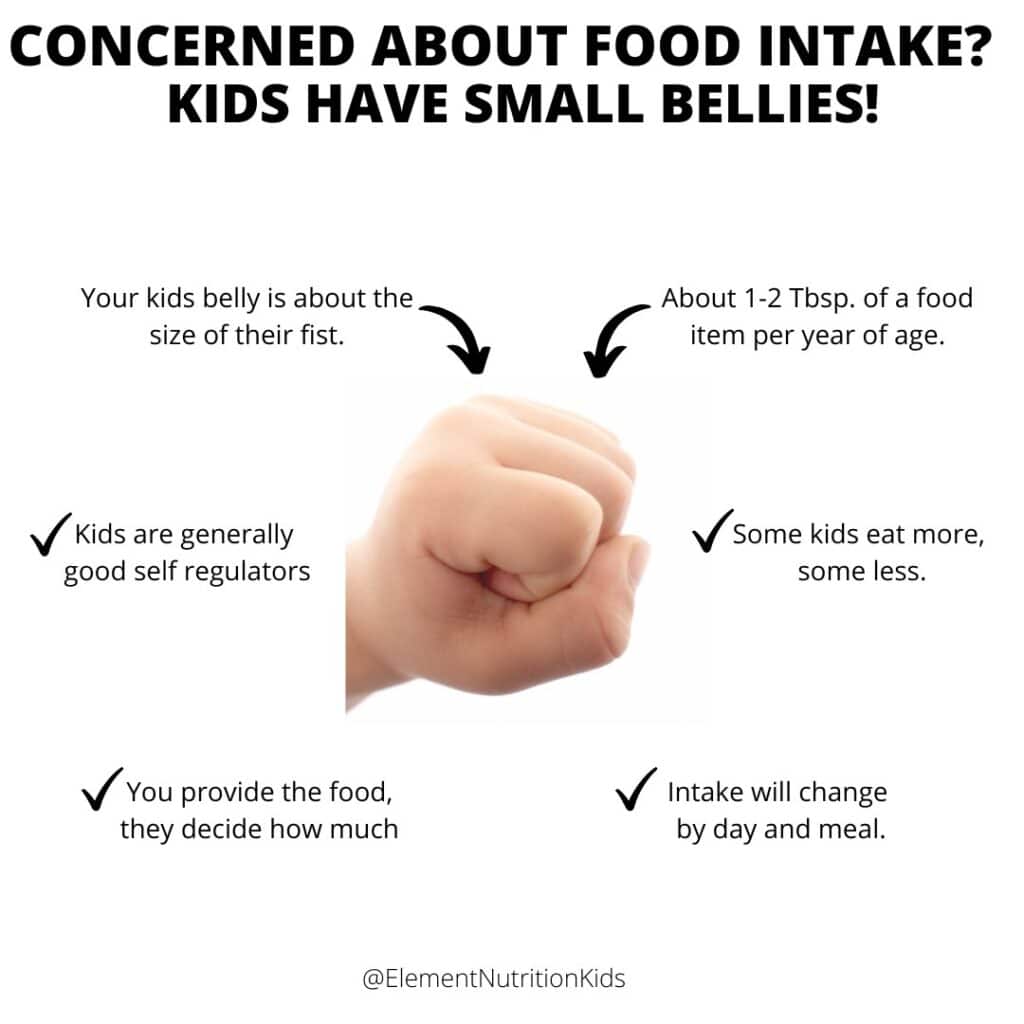
Too much food on your toddler’s plate can be overwhelming, and this can lead to throwing food. Starting small with portions may help prevent that.
Sample menu for 1-year-old with portions
- 1-2 tablespoons shredded chicken
- 1-2 tablespoons diced strawberries
- 1-2 tablespoons steamed broccoli
- ½ slice of garlic bread
Sample menu for 2-year-old with portions
- 2-4 tablespoons shredded chicken
- 2-4 tablespoons diced strawberries
- 2-4 tablespoons steamed broccoli
- ½ slice of garlic bread
Sample menu for 3-year-old with portions
- 3-6 tablespoons shredded chicken
- 3-6 tablespoons diced strawberries
- 3-6 tablespoons steamed broccoli
- ½ slice of garlic bread
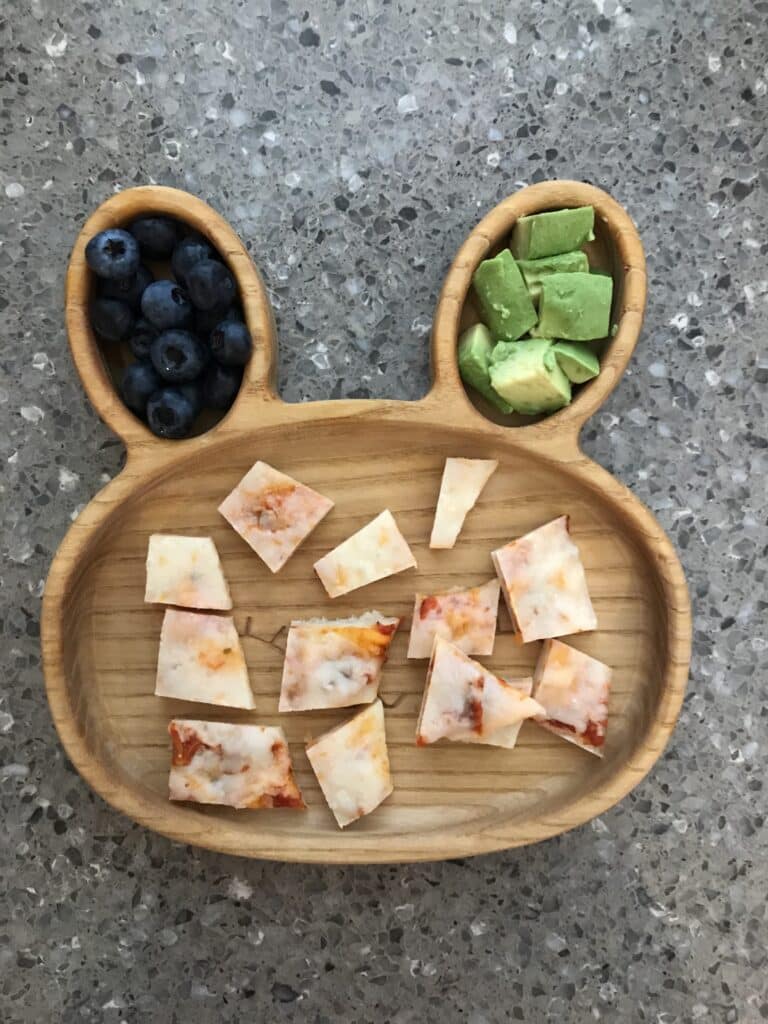
9. Serve at least 1 food that is familiar to them at each meal
The problem: they don’t like any of the food on their plate
It can be tempting to want to try out new recipes and introduce them to all the foods and flavors. Especially if you have heard about the importance of exposure to new foods for toddlers. But toddlers also need to have familiar foods on their plates at every meal for comfort.
Serving your toddler a plate full of new foods is a surefire way to entice a thrower to start throwing food. If they look at the plate and see nothing they want to eat, they just might toss it. Toddlerhood is often when we see picky eating habits start forming, it’s part of their development. So, if your toddler won’t eat, this is part of the solution.
The solution: include at least 1, but ideally 2 “safe foods” at the meal. Safe foods are foods your toddler will eat at least 50% of the time. It can be a fruit, bread, or milk. It could also be some of the components of whatever you’re making.
For example: if you are making spaghetti and your toddler doesn’t like red sauce but does like buttered noodles, then the noodles would be a safe food. You can serve the noodles and the sauce separately, along with whatever else you’re making with the meal.
Common safe foods for toddlers
- Bread
- Fruit
- A favorite vegetable (i.e.: carrots)
- Milk or milk alternatives
- Noodles
- Crackers
- Peanut butter
- Plain rice
Because the common safe foods for toddlers are often very “carby” parents are often worried about their toddler’s protein intake. If you are concerned with your picky eater’s protein intake, you might find this article helpful: high protein foods for picky eaters.
10. Make meals enjoyable and engaging
The problem: they’re bored
You might be reading this and rolling your eyes, but I don’t mean you have to literally entertain your kids during meals. But mealtimes should be enjoyable.
The solution: I mentioned this in step 5, but you should be (as much as possible) sitting with your toddler at meals. Eating alone is boring. Try to use mealtimes to engage with them, talk to them, and just be with them (ideally also eating). And remember, mealtimes are short!
Family meals are a huge part of child development, so try to eat together as a family at least 1x/week. Family meals don’t have to be a huge production, even just 1 parent eating with the kids has positive benefits.
You can also use this time to engage them in food play in a positive way. Instead of throwing food, you can show them how to stack their food, talk about their food, or play with their food in a way that keeps it on the tray.
Helping your toddler engage with foods they don’t like is also a good way to increase their comfort level with that food, which, over time, might lead to tasting and even eating.
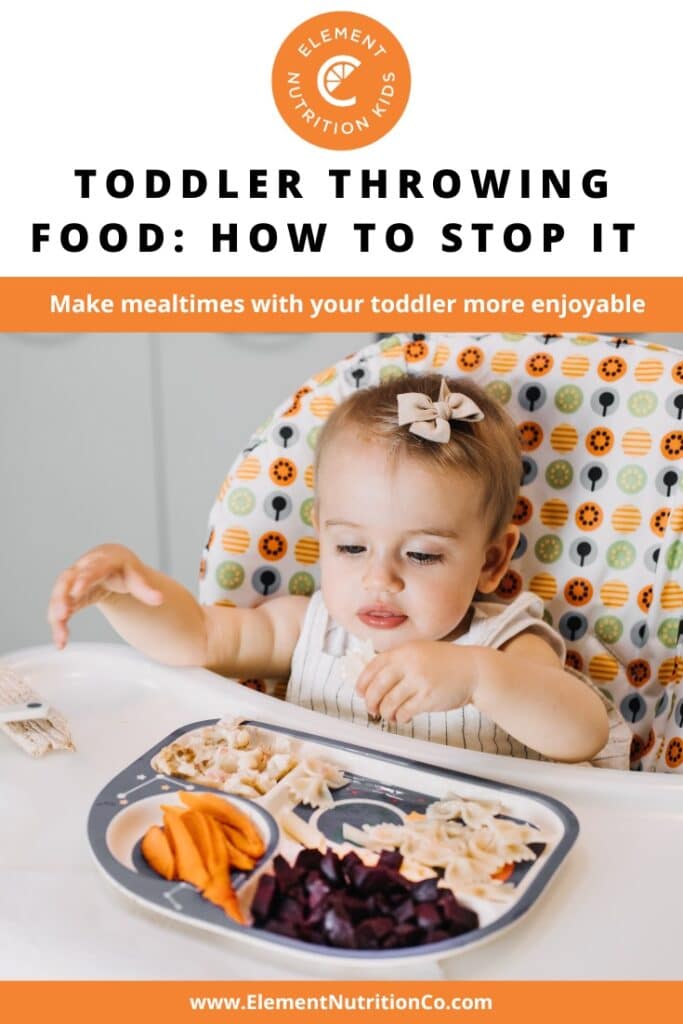
Summary
If you are experiencing your toddler throwing food it can be frustrating. However, you can improve the mealtime experience by following these ten steps.
- Create a feeding schedule to help them come to the table with an appetite to eat.
- Keep mealtimes short which is developmentally appropriate for toddlers.
- Show your toddler how to communicate with you by teaching them signs and also showing them where unwanted food should go on their plate or tray.
- Ensure they are sitting in a chair that supports their body and their feet.
- Sit at the table with your kids as often as possible for meals.
- Set up a time before the meal to throw balls or toys to get that sensory need out of their system.
- Keep your dog in a different room during mealtimes.
- Serve them appropriate portion sizes, starting small and letting them ask for more.
- Avoid serving them a whole plate of unfamiliar foods. Instead include 1-2 safe foods (foods they will eat at least 50% of the time) at each meal.
- Make meals enjoyable and engaging by eating with your child and participating in structured food play at the meal.
I hope you found this article helpful, and if you did, I’d love for you to share it with a friend who might find it helpful too!
If you could use some extra help and support navigating challenging mealtimes with your child, or with their nutrition, seeking help from a pediatric dietitian could help. You can book a coaching call with me here.
Don’t forget to sign up for “The Good Bite” my monthly nutrition newsletter where I send updates on new articles I publish as well as other nutrition and food ideas for your kids!

